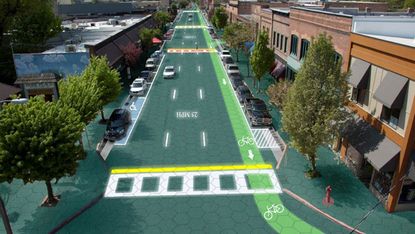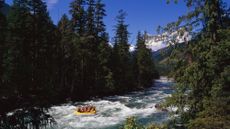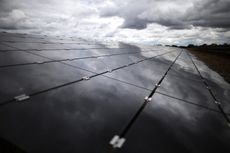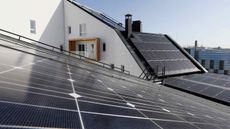Solar-powered roads could refuel cars as they drive
Solar Roadways seeks $1m by the end of the month to put its working prototype into production

A NETWORK of solar-powered roads made of durable textured glass could recharge electric vehicles while they're on the move, according to the founders of Solar Roadways.
Scott Brusaw, an electrical engineer, and his wife Julie have already built a working prototype outside their electronics lab. Now they're hoping to put the idea into production using money raised through Indiegogo, a crowd-funding website.
Where did the idea come from?The pair set up the company after working on the idea of embedding solar-powered lights and heating elements into the road surface to improve safety at night or in icy conditions.
Subscribe to The Week
Escape your echo chamber. Get the facts behind the news, plus analysis from multiple perspectives.

Sign up for The Week's Free Newsletters
From our morning news briefing to a weekly Good News Newsletter, get the best of The Week delivered directly to your inbox.
From our morning news briefing to a weekly Good News Newsletter, get the best of The Week delivered directly to your inbox.
Having developed suitably rugged solar cells, they looked into how they might use them to generating electricity for the national grid – or to power the cars running over them.
In 2009 the couple received the backing of the US Federal Highway Administration, and they began testing their ideas with a team of researchers. In 2011, they were awarded a follow-up contract to build a solar-powered parking lot that could be tested in real-world weather conditions.
What is a solar road?Instead of asphalt or concrete, the surface of a solar road would consist of panels coated in super-strong, high-grip glass. They incorporate the heating element from the original prototype to keep them free from ice.
Underneath the glass sits a bank of solar cells which feed electricity into a “cable corridor” alongside the road. According to the Solar Roadways website, the new road “would pay for itself over time” by selling electricity to the grid.
How much energy could they produce?A substantial amount, according to the creators. "We learned that the US had over 72,000 square kilometers of asphalt and concrete surfaces exposed to the sun,” Scott Brusaw told CNN. “If we could cover them with our solar road panels, then we could produce over three times the amount of energy that we use as a country."
When will production start?Production will begin once the project reaches its funding goal of $1m, for which the company has set a target date of May 31. The campaign has so far raised $100,000.
Solar road surfaces are likely to make their first appearances in car parks and driveways before being rolled out onto the road network.
Create an account with the same email registered to your subscription to unlock access.
Sign up for Today's Best Articles in your inbox
A free daily email with the biggest news stories of the day – and the best features from TheWeek.com
-
 6 scenic white water rafting destinations to get your heart racing
6 scenic white water rafting destinations to get your heart racingThe Week Recommends Have a rip-roaring time on the water
By Catherine Garcia, The Week US Published
-
 Dangerous substances in Lunchables are raising concerns over children's health
Dangerous substances in Lunchables are raising concerns over children's healthIn the Spotlight High levels of lead and sodium were recently found in the snack packages
By Justin Klawans, The Week US Published
-
 The Week contest: Fired art
The Week contest: Fired artPuzzles and Quizzes
By The Week US Published
-
 Free solar panels for 800,000 low-income homes
Free solar panels for 800,000 low-income homesSpeed Read Reports say the £1bn government scheme will create more than 1,000 new jobs
By The Week Staff Published
-
 Ikea starts selling solar battery system in UK
Ikea starts selling solar battery system in UKSpeed Read System will save hundreds each year, says company, but report warns it comes at a 'big up-front cost'
By The Week Staff Published
-
 Mercedes targets Tesla with home battery system
Mercedes targets Tesla with home battery systemIn Depth Electricity storage system reportedly cheaper than Tesla's Powerwall 2, but doesn't store as much power
By The Week Staff Published
-
 Solar Impulse 2 plane completes first Atlantic crossing
Solar Impulse 2 plane completes first Atlantic crossingSpeed Read Zero-fuel plane lands in Spain after becoming first solar-powered aircraft to make symbolic journey
By The Week Staff Published
-
 Solar Impulse II: Swiss pilots to circle globe in solar plane
Solar Impulse II: Swiss pilots to circle globe in solar planeSpeed Read Aircraft unveiled this week has a wingspan greater than that of a 747 but weighs just 1.6 tonnes
By The Week Staff Published